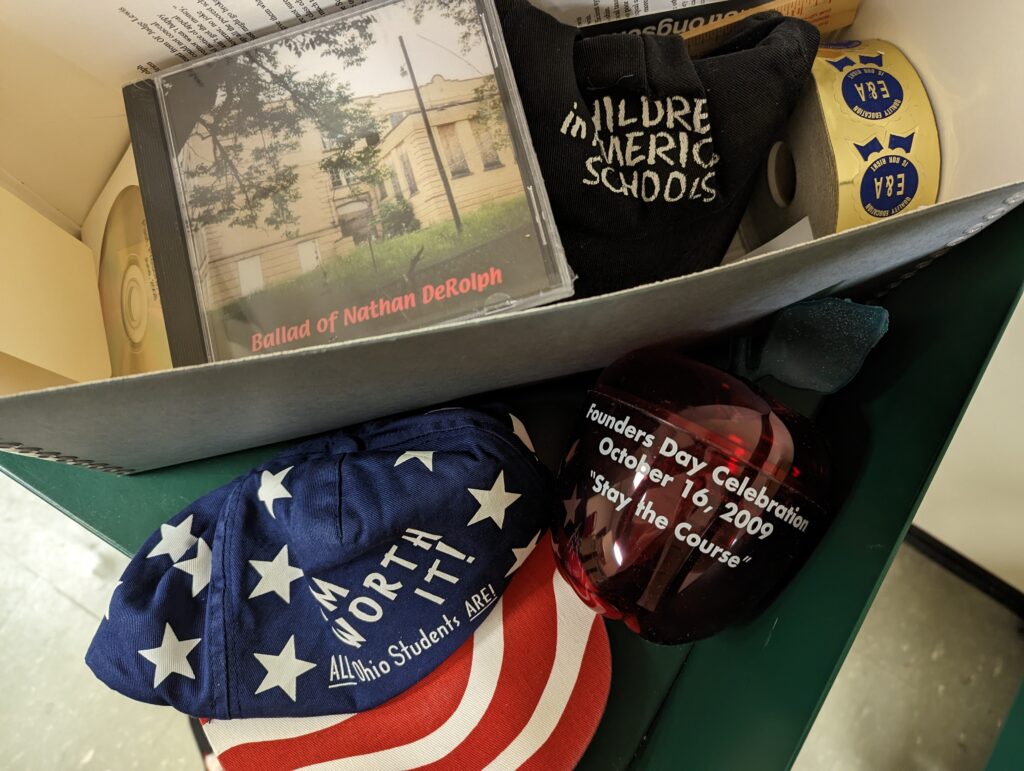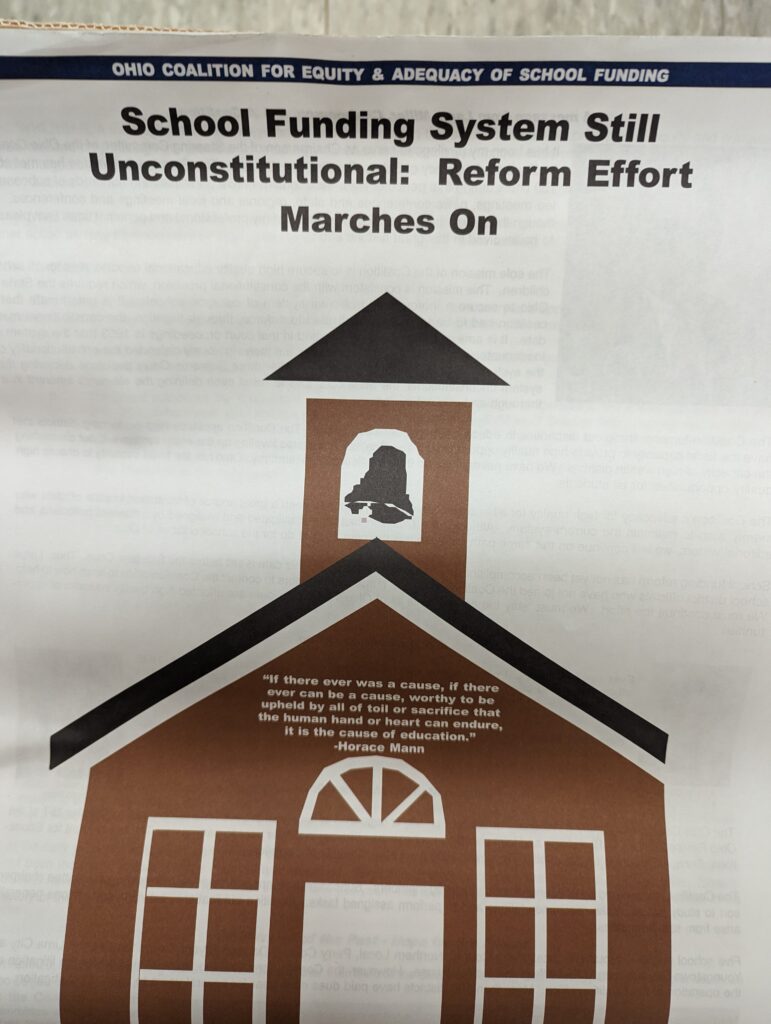By Lizzy Daly, Communication Studies ’23, Margaret Boyd Scholar, Archives Assistant
As an Archives Assistant for the manuscript collection in the Mahn Center, I have spent the majority of my time processing the Ohio Coalition for Equity and Adequacy of School Funding (OCEASF) collection , which was donated by its founder Bill Phillis. Spending time with this collection allowed me significant exposure to the historical issues in public education in Ohio. Issues the collection addresses, such as charter schools, school choice vouchers, inequity of school funding formula, and the challenges of under-resourced schools in rural and urban contexts, continue to impact the effectiveness of the state of Ohio’s education systems. Processing this collection has encouraged me to re-contextualize how I view the condition of public education in Ohio through the guidance of the papers and documents of Bill Phillis and the OCEASF.

The Ballad of Nathan DeRolph and Regional Connections:
“It’s raining in the library, there’s puddles in the halls. There’s coal dust in my textbooks,
and you could punch holes in these walls. But the state ain’t got the money to fix up this
old school, so I’m going to the next county and jump in their olympic pool.”
– The Ballad of Nathan DeRolph
The story of the Ohio Coalition for Equity & Adequacy of School Funding (OCEASF) begins in Perry County, a county in southeastern Ohio located only forty miles north of Athens. The school funding model for the state of Ohio has historically relied heavily upon property taxes to provide revenue for school funding. This reliance upon property tax creates inequity in school funding based on the districts they reside in. In 1991, the OCEASF filed a lawsuit against the state of Ohio in the name of Nathan DeRolph, a high school student in a Perry County School District. This lawsuit claimed that an overreliance upon property taxes created inequitable conditions and opportunities in public schools. Essentially students in Perry County and other poorer districts were not given the same opportunities and educational experiences as schools in surrounding high-property value districts.
The Ballad of Nathan DeRolph was among the materials created during the timeline of the DeRolph case. As highlighted in the snapshot of lyrics above, the ballad tells the story of an underfunded education from the standpoint of student Nathan DeRolph. Highlighting themes such as lack of learning material, failing school infrastructure, and lack of support for extracurricular activities, this ballad follows the deep tradition and history of storytelling in Southeastern Ohio, calling for equity in the form of a song.
The backstory of OCEASF also begins locally. Research from The Coalition of Rural and Appalachian Schools (CORAS), which works in partnership with and with support from the Patton College of Education at our very own Ohio University, prompted the creation of OCEASF. In the late 1980s, CORAS focused on funding studies and research to improve students’ educational experience in public schools in Appalachia, Ohio. One study funded by CORAS and completed by Dr. Kern Alexander concluded that Ohio’s school finance system was both inequitable and inadequate. These findings inspired CORAS and district superintendents statewide to organize into a broader coalition focused exclusively on challenging the constitutionality of Ohio’s school finance system. Consequently, in 1991 the Ohio Coalition for Equity & Adequacy of School Funding was formed.


Bill Phillis, Letter Writing, and A Grass-roots Approach to Education Activism:
Spending time with the files of the OCEASF collection entrenched me in the grass-roots mechanisms Bill Phillis and the OCEASF utilized to garner public support for education reform in Ohio. Phillis responded to almost every letter, fax, or email he received. For any speaking event that Phillis spoke at, he immediately wrote a thank you note to whoever hosted the event or invited him to speak. While some may view this as a small act, this ongoing correspondence with individuals that Bill Phillis engaged in was purposeful and noteworthy. This continuous letter writing, receiving, and responding was time-consuming. Yet, as I continued to examine this collection, I realized that this was a grass-roots strategy used to garner continued support and interest in school funding in Ohio.
Education, particularly public education, is a central institution in the United States society. Yet public interest in education is often seen as only a “parent’s issue.” Phillis led the charge of expanding public interest in educational policy and garnering support for school funding reform in Ohio. Phillis kept community members involved by keeping them engaged and updated in the continuously developing landscape of education policy, a task Phillis is still continuously working towards through the OCEASF coalition and a lot of letter writing.
Impacts of Charter Schools Statewide and Regionally:
The original intent of charter schools was to allow for less regulation of education, allowing schools to be more creative and innovative. Charter schools are independently managed, publicly funded, and not subject to state and federal curriculum requirements. The state of Ohio legalized charter schools in the 1990s, and since their legalization, they have become an extremely profitable industry.
A significant issue in Ohio is the mismanagement of funds within charter schools. An article by the Akron Beacon Journal (2015) revealed in its review of audits released in 2014 by the state that Ohio charter schools misspent public money at a rate “nearly four times more often than any other type of taxpayer-funded agency.” Ohio has allowed charter schools to open and operate with nearly no oversight, and the state of Ohio has a deep history of corruption within charter schools. Bill Phillis and the OCEASF stand firmly against the movement of public funding away from public schools towards charter schools and are particularly critical of the language and rhetoric surrounding charter schools. For example, Ohio charter schools often are referred to as “community schools,” a representation that Phillis argues devalues the sense of community and place that public schools foster in communities.
To bring this issue closer to home, Southeast Ohio Classical Academy, a new charter school, is set to open in Athens, Ohio, in 2024. Southeast Ohio Classical Academy will be state and federally funded. If a student leaves an Athens county public school to attend Southeast Ohio Classical Academy, the state and federal money will leave the Athens public school district with the student. Not only will this impact the educational budget for Athens County Schools, but the critics have suggested that the curriculum planned to be taught by Southeast Ohio Classical Academy is divisive.
Southeast Ohio Classical Academy will utilize Hillsdale’s 1776 Curriculum, criticized by many historians and educational advocates as being revisionist, most notably showcased through lessons focused on the founding father’s perceptions of slavery and the civil rights movement. In addition, this curriculum includes sections on modern social movements. Claiming that modern and current social movements are not focused on the founding father’s ideas of equality but on identity politics that make it “less likely that racial reconciliation and healing can be attained.” (p.63). The curriculum also criticizes affirmative action and critical race theory.
Phillis commented on the potentially dangerous nature of this divisive and revisionist curriculum in a statement to WOUB, stating that “Hillsdale is pushing an ideology that doesn’t really tell the whole story. Our system should lead to the common good, what’s good for everybody. And these kinds of arrangements lead to tribalism”. Phillis has remained vocal in conversations surrounding charter schools in Ohio, explicitly remaining critical of the lack of regulation of charter schools and continuously advocating for accountability and transparency from the charter school industry.
George V. Voinovich and Ohio University Archives:
Ohio University’s Mahn Center for Archives and Special Collections is home to the Gubernatorial Collection and the Senatorial Collections of the late senator and former governor of the State of Ohio, George V. Voinovich, which makes it aptly the place also to house the OCEASF collection.
In 1997 the Ohio Supreme Court ruled that Ohio’s method of school funding was unconstitutional in the DeRolph case. At the time, Voinovich was the governor of Ohio. Voinovich publicly denounced the Ohio Supreme Court ruling, significantly criticizing the decision as an “overreach” and a form of “judicial activism.” Former Governor Voinovich and the OCEASF had notably differing opinions on how to remedy the educational system of the state of Ohio.
A 1994 article in the Cleveland Plain Dealer titled “Voinovich Assails Schools Over Lawsuit” exhibits these countering opinions. In this article, Goel (1994) captures Voinovich’s opinion that school districts should make do with less through a direct quote from the then-governor, stating, “It’s time for results. It’s time to get something out of our money… They have to do what everybody else has to do. They have to restructure.” In response, Phillis commented, “I would invite the governor and his staff to visit some of these districts and show them how to get more for the buck… He would find kids going to school without bathrooms. He would find kids going to school in coal bins.”.
The placement of the OCEASF collection alongside the Gubernatorial Collection and the Senatorial Collections of Voinovich in the Mahn Center at Ohio University allows individuals to explore both sides of the story of school funding in the state of Ohio.

Current State of the Collection:
The experience of processing this collection has been equal parts tedious, rewarding, and fascinating. The collection spans almost thirty years and includes material from court documents to personal thank you cards. It is vast and wide-ranging, which made arranging materials into series and subseries vital to comprehending the collection’s content.
My first order of business was coalescing all material related to the steering committee, the governing body of the OCEASF. Sorting through and rearranging the documents into chronological order allowed me to overview the work of OCEASF from the early 1990s to the mid-2010s. From there, we began to identify and categorize series within the collection. The content of various series includes Administrative Records, Correspondence, Steering Committee, Background Materials, The DeRolph (I, II, III) Court Case Documents, Press and Media, and Awards. Through my time, I have processed and organized the Steering Committee, Awards, and Press and Media series. However, the time spent with this collection thus far has created a deep appreciation for those who work tirelessly advocating for a strong, equitable, and enriching public school system.
